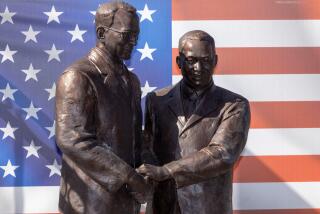Salvadorans hope dedication of square spurs more recognition
Under cloudless skies and a radiant sun, a couple of hundred Salvadorans dressed in white gathered early Saturday to name an intersection near downtown Los Angeles in honor of Msgr. Oscar A. Romero, a Catholic archbishop who was slain in 1980 during El Salvador’s civil war and whom many consider a martyr.
White doves were released; a tree was planted. Speakers recounted Romero’s struggle on behalf of the poor and his assassination. His words — “If they kill me, I will be reborn in the Salvadoran people” — were invoked throughout the morning.
But Saturday’s ceremony and the naming of the square where Pico Boulevard and Vermont Avenue meet has more to do with Salvadorans’ place in Los Angeles than anything that happened in their home country years ago.
“Most ethnic groups have their representations — Chinatown, Little Armenia, Little Tokyo,” said Raul Contreras, a truck driver. “We don’t.”
As one of the largest Latino groups in the county, “we deserve a spot to show our culture and what we’re capable of,” Oscar Dominguez, a financial advisor who organized the naming of the square, told the crowd.
Dominguez and others hope the square will lead to the naming of an El Salvador Community Corridor along Vermont from 11th Street to Adams Boulevard, home to many Salvadoran-owned businesses. They hope such a corridor will, in turn, awaken Salvadorans to the need for more civic engagement in an area that has largely been dominated by the economically powerful Korean community.
The move to name the intersection after Romero began two years ago, when Salvadoran leaders learned that Korean activists wanted to designate an “official” Koreatown boundary that included areas Central Americans, especially Salvadorans, considered theirs: south to Pico Boulevard and east to Hoover Street.
The issue galvanized and united Salvadorans, including longtime leaders still divided because of the 12-year civil war that ended in 1992, said Raul Claros, a Salvadoran American activist.
After hearing about the proposed Koreatown expansion, more than three dozen leaders flooded a City Council committee hearing to protest the boundary designation.
“I knew it was for real when I saw certain [Salvadoran] icons who don’t like each other sitting next to each other,” Claros said.
The official Koreatown boundaries were shrunk to encompass about half of what was initially proposed: Olympic Boulevard to the south, 3rd Street to the north, Vermont to the east and Western Avenue to the west.
The effort marked the first public Salvadoran initiative undertaken primarily by young business owners and Salvadoran Americans, who formed nonprofit service organizations in the 1980s and have been the face of the community since it took shape.
After the Koreatown proposal surfaced, community leaders formed the Latino Coalition and succeeded in naming an elementary school for Jose Castellanos, a Salvadoran colonel who saved thousands of Jews from Nazi persecution during World War II by providing them with false Salvadoran citizenship papers.
They hope this year to back a Salvadoran candidate for the City Council for the first time. They are also supporting similar ethnic business corridors for people from the Mexican state of Oaxaca along 8th Street and for Guatemalans along 6th Street.
But the boundary issue frayed relations between the Salvadoran and Korean communities.
Koreans own large tracts of real estate in the area. Several Korean banks are widely perceived among Latinos as performing little outreach to potential customers from other countries.
“The Koreans are a very powerful economic force,” said Wilson Salguero, owner of a Vermont Avenue restaurant. “They’re good citizens. [But] our voices seem to be drowned out by their economic voice.”
Korean economic power in the area “doesn’t give a lot of chance for us who live here to grow,” Dominguez said. “By having areas that identify with the community, maybe they’ll realize that they cannot expand.”
Grace Yoo, director of the Korean American Coalition, said she had not heard of the square’s designation but thought that a Salvadoran corridor had already been approved. “As I’m unaware as to what the facts are at this point, I’d be unable to make any informed comment,” she said.
Salvadoran activists lament that their community hasn’t done more to mend fissures from the civil war that brought hundreds of thousands of Salvadorans to Los Angeles, especially to the neighborhoods just west of downtown.
Salvadorans need to “begin thinking of one another as brothers and sisters and do away with the envy and wanting to outdo one another,” said Isabel Cardenas, a longtime activist. “If we start a real reconciliation and help one another, just like the Koreans and the Jewish community … we’d be able to be successful — outside and inside of our country.”
Few Salvadorans believe that a plaza or a corridor will change economic relations in the area.
“In our community, there is a stereotype that when they see someone Asian, the kids think that person is better than them,” Dominguez said. “But if they see we have areas that are ours and we have businesses that are ours, it creates a new generation able to lift themselves.”
Meanwhile, Salvadoran leaders hope that Romero Square will hasten the city’s recognition of the corridor, in the works since 2010. A California Department of Transportation official said a sign announcing the corridor has already been approved for the Vermont exits from the 10 Freeway.
“We’re trying to put a tiny flag saying we’re here,” said Salguero, who grew up in Koreatown.
More to Read
Start your day right
Sign up for Essential California for news, features and recommendations from the L.A. Times and beyond in your inbox six days a week.
You may occasionally receive promotional content from the Los Angeles Times.






